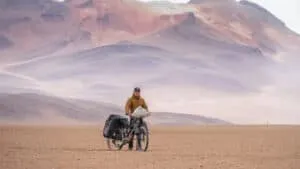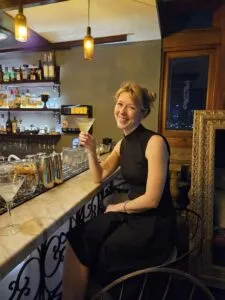
Imagine the South American road trip of a lifetime—18,000km down the entire length of the continent; traversing mountains, glaciers, deserts, and salt lakes.
And now, imagine doing it all on two wheels. This is the remarkable feat undertaken by Dimitri Poffé, all to raise awareness for a rare genetic disorder.
Confronted with the challenges of Huntington’s from an early age, Dimitri lost his father to the disease when he was just a teen and has watched his sister battle with the same condition for over a decade.

In his late 20s, Dimitri decided to get tested to determine whether or not he carried the gene for Huntington’s. With the results coming back positive and Dimitri destined to develop the same condition that had gripped his family for decades by the time he was 40, he was driven to pursue a lifelong dream: travel the world while still asymptomatic, and raise awareness for Huntington’s as he did.
Embarking on an incredible 18,000km journey from Mexico to Ushuaia, all on his bicycle, the ExploreForHuntington project was born. Meeting researchers, associations, and patients along the way, Dimitri’s story is a testament to the strength of the human spirit and one man’s incredible fight against the odds.
We spoke to Dimitri about his motivations for exploring South America, the landscapes he encountered, and his plans for ExploreForHuntington.
Firstly, can you share a little more about why you decided to embark on this incredible journey?
I decided to take this trip to put my skills and experiences to the benefit of the Huntington community. I love sport, nature, adventure, travelling, discovering new cultures, meeting people, and learning languages, so it was the perfect combination of that.
What inspired you to choose South America?
I actually chose South America because it is the most affected region in the world with Huntington’s disease. But also for the richness of its landscapes and cultures.
Where were the most breathtaking landscapes, in your opinion? Could you describe how they impacted you?
The most impressive landscapes for me are in the Andes. From Southern Colombia to Patagonia, this mountain range is truly impressive. I love feeling insignificant in the face of the grandeur of the mountains, nothing beats it.

How were your encounters with locals along your journey? How did you find their culture and hospitality?
I had many wonderful encounters during my journey! Travelling by bike really allows you to live very intense human experiences. The solidarity of the people is incredible. The locals have always been kind to me and helped me in any situation.
You only recently reached the end of your journey, how was your reception in Ushuaia, and how did it feel to complete this incredible feat?
I am happy because I managed to meet two patients with Huntington’s in Ushuaia and show the international community that even at the end of the world, there are cases of Huntington’s. I also succeeded in collaborating with many media outlets to give visibility to the disease and my project. It’s a strange feeling to arrive at the end of such a journey. I really went through all the emotions you can imagine.
Which country do you think left the strongest impression on you?
I don’t think I can select a specific country. Each and every one has its positives and negatives, and my experiences were different in each.
How did the challenging terrains and climates affect the cycle? Were there any moments when you felt particularly tested physically or mentally?
What was particularly challenging were the desert regions—endless roads, thousands of kilometers long, where there is absolutely nothing and no one. It was also difficult to get water and food in these places, for example, Ruta 40 in Argentina. Also, you have two options when crossing Latin America: follow the coast, but suffer from the heat and the humidity, or follow the Andes mountain range, where there is a lot of elevation, and you have to deal with the altitude. I chose the second option because I can’t deal with the heat. So I followed the Andes Cordillera from Southern Colombia to Patagonia, and it was very physically challenging.

Can you recommend any hidden gems or off-the-beaten-path destinations to adventurous travelers?
I really recommend Northern Peru, the towns of Jaén, Cajamarca, Huamachuco, Caraz, and Huaraz in particular. The Huascarán National Park is also very beautiful, and there are many cycling routes that I followed thanks to the site “bikepacking.com” (The Peru Great Divide, for example, which runs for 1,600 kilometers from Huaraz in the north region to Abancay in the south.) What I really like about cycling is getting lost in isolated villages where there is absolutely no tourism, so the encounters with the locals are truly grandiose and authentic.
In what ways were you able to help shed light on Huntington’s Disease during your journey?
Before starting my trip, I searched social networks for contacts related to Huntington’s—Families, patients, doctors, associations, etc. I already had a network before arriving, and I built my itinerary around meeting this network. We are talking about a rare disease here, and there are still many undiagnosed patients, especially in Latin America, where many regions have restricted healthcare access. It is essential to increase visibility and engage new communities in discussions about Huntington’s. I collaborated with many local media outlets and helped connect them with the French media so they could work together. With my links in Europe, I shed light not only on Huntington’s but Huntington’s in Latin America. I’ve also raised a lot of funds throughout my journey.

How did traveling by bicycle enhance your appreciation for the landscapes?
Traveling by bike allows you to take your time. We have time to really enjoy and be part of the environment, and we have time to meet a lot of people. The goal of cycling is to enjoy the journey, not the destination.
For travelers who are interested in exploring South America, what advice would you give them based on your own experiences?
First, I recommend not listening to clichés and stereotypes. I have heard too often that Latin America is dangerous and has a lot of crime. Believe me, I never once felt in danger. On the contrary, people were always willing to offer a helping hand whenever I needed it! This might not be the same for everyone. I’m not saying there is no crime either, but it’s a minority—very often concentrated in the big cities. Cycling around you’re in rural areas 90% of the time. I have never met such friendly, simple, open-minded, and helpful people as in Latin America. Really you can’t imagine how touched I was by the love people share for you here.
Lastly, what have you got planned for the future? Do you have any upcoming projects in the works?
I am currently working with a friend, Timothy Dhalleine, and his company, “Cascada Expediciones,” on a documentary called The Present. I hope to find sponsors in the future to continue this project in other countries and help the international Huntington’s community even more. Read more about Dimitri’s incredible story, his upcoming documentary, and ways below.
LEARN MORERelated Stories

Discovering the Colombia of 100 Years of Solitude: a journey inspired by Gabriel García Marquez

Art Travel in Mexico City

Cuba with Hattie: A Journey to Havana and Trinidad

Uruguay: The Ultimate Road Trip
@plansouthamerica


